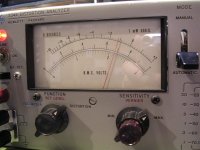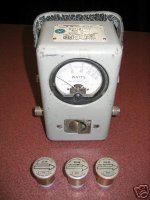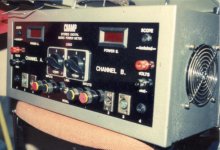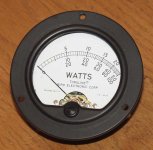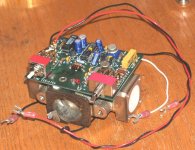Hi all,
Well, I saw an HP 334A Distortion Analyzer on Eeeek bay for about $50 USD, so I bought it. The company selling it didn't really know what they had, so I figured I was lucky that day. Shipping was amazing as it arrived two days later.
Okay, so it didn't power up. Fixed that and found it wouldn't respond to any signals (noticed that the meter pointer was bent as well). Traced and repaired that and also repaired the next fault, intermittent operation. So now it seems to work. This leaves me with one last problem.
How does one properly straighten out a bent pointer in a really nice, well built meter? I would hate to break it. I currently have it out on my bench and disassembled. The scale is covered with taped down paper so I don't mark it up.
-Chris
Well, I saw an HP 334A Distortion Analyzer on Eeeek bay for about $50 USD, so I bought it. The company selling it didn't really know what they had, so I figured I was lucky that day. Shipping was amazing as it arrived two days later.
Okay, so it didn't power up. Fixed that and found it wouldn't respond to any signals (noticed that the meter pointer was bent as well). Traced and repaired that and also repaired the next fault, intermittent operation. So now it seems to work. This leaves me with one last problem.
How does one properly straighten out a bent pointer in a really nice, well built meter? I would hate to break it. I currently have it out on my bench and disassembled. The scale is covered with taped down paper so I don't mark it up.
-Chris
I just picked up a 334 that's kinda beat (like I need another distortion meter), and paid twice that for it- you did well. Though I've fixed various meters, never an HP. Ultimately, you'll just have to carefully bend it back, without putting undue stress on the pivots. It will either break or it won't, depending on how much it's bent. A slight bend can usually be fixed with no problem- how bad is it? You'll need to immobilize the pivot side somehow. Armchair idea- use a little block of wood to press the pivot side against, maintaining the height, while you bend the rest back. Caveat emptor. If worse comes to worst, you might be able to pick up another meter of the same type at a hamfest or some other piece of HP equipment on eBay. I've been known to make new scales for meters by scanning the old one and reprinting it on good paper, or drawing a new one in CAD. Though the rest of my 334 is ok, the front handle is broken off on the right side, so I'm in the market for any HP junker in the same size chassis, with a good right side panel.
Hi Conrad,
I managed to straighten the pointer out. Using some metal blocks to support the meter, and another to support the pointer, I managed to gently get rid of the bends. This is a shot of it now. These pointers are very brittle, so you have to work very carefully. I didn't go for perfection, just much better.
You should have seen this instrument when I got it. It was filthy and banged up. I did strip the entire faceplate and removed the meter (what a pain!). While doing this I scrubbed everything down and lubricated the bearings on all the controls and switches. The frequency dial was seized - no surprise there. My coupling between the frequency dial and the capacitor was lying shattered in the bottom. The capacitor was also seized. After the cleaning was done, the meter was attempted. It had two good sized bends in it. I should have taken a shot of it before I started.
The capacitor was also seized. After the cleaning was done, the meter was attempted. It had two good sized bends in it. I should have taken a shot of it before I started.
These distortion analyzers are great units. They are easily better than my Leader LDM-171 (bought new). The usable range is up to 600 KHz and the response is up to a couple MHz. I also have an HP 339A that I really like. The 339A doesn't go up that high in frequency, so the 331A ~ 334A are perfectly useful on most benches. Keep in mind that you can float the input terminals to about 400 V pk (remove the ground strap!) on these older units. The analog meters are typically dead on the money with HP gear.
I have one fault left to repair (I hope), then the unit can be checked for calibration. So, one meter saved from the scrap pile.
-Chris
I managed to straighten the pointer out. Using some metal blocks to support the meter, and another to support the pointer, I managed to gently get rid of the bends. This is a shot of it now. These pointers are very brittle, so you have to work very carefully. I didn't go for perfection, just much better.
You should have seen this instrument when I got it. It was filthy and banged up. I did strip the entire faceplate and removed the meter (what a pain!). While doing this I scrubbed everything down and lubricated the bearings on all the controls and switches. The frequency dial was seized - no surprise there. My coupling between the frequency dial and the capacitor was lying shattered in the bottom.
These distortion analyzers are great units. They are easily better than my Leader LDM-171 (bought new). The usable range is up to 600 KHz and the response is up to a couple MHz. I also have an HP 339A that I really like. The 339A doesn't go up that high in frequency, so the 331A ~ 334A are perfectly useful on most benches. Keep in mind that you can float the input terminals to about 400 V pk (remove the ground strap!) on these older units. The analog meters are typically dead on the money with HP gear.
I have one fault left to repair (I hope), then the unit can be checked for calibration. So, one meter saved from the scrap pile.
-Chris
Attachments
Well that sure looks good to me! I haven't had a chance to fool with mine yet. I fixed up a 331 some time back, but really wanted a 334, so I sold it, probably for $20 or so at a hamfest. My 334 has the optional RF input, though I'm not exactly sure what to do with it- still have to find a manual to download somewhere. Years ago I built the Bob Cordell THD analyzer that was published in Audio magazine. It's a remarkable instrument with a floor of about 0.0002% over most of the range. It's also easier to use than most any other analyzers. Right now I'm using an HP 8903B Audio Analyzer that I got a good deal on surplus, because I can talk to it via GPIB. I wrote a simple program that runs response curves, THD curves, gain and signal to noise numbers, all in a minute or so. Being able to do that at the touch of a button has really improved my optimization, but for the best numbers I go back to the Cordell unit.
Hi Conrad,
PM me please.
I'd like to pick up the 8903A sometime. I have a lot of respect for HP instruments from all the ones I've come into contact with over the years. I find the 339A pretty easy to use also.
I did get a 331A to rebuild. I think they are worthwhile compared to the Leader I have. I also have a 652A and a 654A to rebuild.
-Chris
PM me please.
I'd like to pick up the 8903A sometime. I have a lot of respect for HP instruments from all the ones I've come into contact with over the years. I find the 339A pretty easy to use also.
I did get a 331A to rebuild. I think they are worthwhile compared to the Leader I have. I also have a 652A and a 654A to rebuild.
-Chris
You should be able to find a lot of downloadable HP test equipment manuals at http://bama.sbc.edu/hp.htm .
I got an HP 334A on ebay, a couple of years ago, for about $180 including shipping. But it appeared to be in perfect condition, and even well-calibrated. (I had intended to pay more to get a working one, since I needed it for a job at the time.)
I wish I still had more of the HP stuff I used to buy, refurbish, and resell, up until a few years ago. I mostly dealt with Tektronix scopes. But I probably also had about a hundred or so nice pieces of HP gear go through here. Some of them were exquisite.
You guys REALLY ought to check out http://www.govliquidation.com .
It's not quite as good as it used to be, from a reseller's point of view, since it's not all sealed bids and larger lots, any more. But you might be able to get three of something for the price of one on ebay. It's riskier, in many ways, but, I think, better in many ways. Some stuff is even "unused". Even just going to one of the larger test equipment sale sites during the pre-sale "inspection period" is a very memorable experience!
Try their Advanced Search option and select warehouses within a few hours of you, if possible, for the next big monthly test equipment sale, and see what comes up.
- Tom Gootee
http://www.fullnet.com/~tomg/index.html
-
I got an HP 334A on ebay, a couple of years ago, for about $180 including shipping. But it appeared to be in perfect condition, and even well-calibrated. (I had intended to pay more to get a working one, since I needed it for a job at the time.)
I wish I still had more of the HP stuff I used to buy, refurbish, and resell, up until a few years ago. I mostly dealt with Tektronix scopes. But I probably also had about a hundred or so nice pieces of HP gear go through here. Some of them were exquisite.
You guys REALLY ought to check out http://www.govliquidation.com .
It's not quite as good as it used to be, from a reseller's point of view, since it's not all sealed bids and larger lots, any more. But you might be able to get three of something for the price of one on ebay. It's riskier, in many ways, but, I think, better in many ways. Some stuff is even "unused". Even just going to one of the larger test equipment sale sites during the pre-sale "inspection period" is a very memorable experience!
Try their Advanced Search option and select warehouses within a few hours of you, if possible, for the next big monthly test equipment sale, and see what comes up.
- Tom Gootee
http://www.fullnet.com/~tomg/index.html
-
Question
In the RF bissnes we use whats is call a Bird meter to check real watts out of a radio trasmiter amp . another word it checks it out the raw watts not peaks like most other cheap meter , With audio who built a similar thing? , for checking true RMS .
In the RF bissnes we use whats is call a Bird meter to check real watts out of a radio trasmiter amp . another word it checks it out the raw watts not peaks like most other cheap meter , With audio who built a similar thing? , for checking true RMS .
Attachments
Hi Tom,
I'm a Canadian! I'd have to buy sight unseen. An audio signal analyzer and RF spectrum analyzer would be (more!!!) than nice.
I'd have to buy sight unseen. An audio signal analyzer and RF spectrum analyzer would be (more!!!) than nice.  I'll bet buying there is less risky that buying from some of the hacks on Eeeekbay.
I'll bet buying there is less risky that buying from some of the hacks on Eeeekbay.
Hi 70s music,
Most of HP's meters have been of the true RMS type for years. I use a 34401A, and could not have made a better choice for what I do. It's also a very good idea to check what you are measuring with an oscilloscope. Also, know the character of your meter. For a handheld multimeter, it's pretty hard to beat a Fluke. They are accurate and hold their calibration (unlike most other meters out there, especially Extech). I'd like to see the new one Agilent just released.
If you count on your test equipment for the correct answers at all, don't buy cheap meters. If all you need to do is see if +12 VDC or 120 VAC is there or not, it's not that critical. At least check a new meter against a known good one before trusting it.
-Chris
I'm a Canadian!
 I'd have to buy sight unseen. An audio signal analyzer and RF spectrum analyzer would be (more!!!) than nice.
I'd have to buy sight unseen. An audio signal analyzer and RF spectrum analyzer would be (more!!!) than nice. Hi 70s music,
Most of HP's meters have been of the true RMS type for years. I use a 34401A, and could not have made a better choice for what I do. It's also a very good idea to check what you are measuring with an oscilloscope. Also, know the character of your meter. For a handheld multimeter, it's pretty hard to beat a Fluke. They are accurate and hold their calibration (unlike most other meters out there, especially Extech). I'd like to see the new one Agilent just released.
If you count on your test equipment for the correct answers at all, don't buy cheap meters. If all you need to do is see if +12 VDC or 120 VAC is there or not, it's not that critical. At least check a new meter against a known good one before trusting it.
-Chris
Chris thanx . But something like this is more what i meant. http://www.chambonino.com/construct/const3.html
Attachments
Hi 70s music,
Okay, all that is, is a dummy load. With a known resistance (I use some Dale 250W, 8R, 1% non-inductive units) you will know the current draw given a measured voltage. If you were to measure this voltage with a meter like an HP 34401A, you would very fairly certain how much power you are dissipating.
If you want to make things easier, use a four quadrant multiplier and sense both voltage and current (they will be in phase for a resistive load). Monitor the output with a meter, like the one suggested. You will have to scale the voltage and current functions first. If you wish to build your own, continue along this line. Run the output into a true RMS converter chip, such as an AD536 (I think). Use a digital panel meter (available on Ebay) to monitor the output.
Now, if you wish to buy this commercially, it will cost you a fortune. Bet's are that most devices will not respond to the waveforms using a true RMS conversion.
Okay, all that is, is a dummy load. With a known resistance (I use some Dale 250W, 8R, 1% non-inductive units) you will know the current draw given a measured voltage. If you were to measure this voltage with a meter like an HP 34401A, you would very fairly certain how much power you are dissipating.
If you want to make things easier, use a four quadrant multiplier and sense both voltage and current (they will be in phase for a resistive load). Monitor the output with a meter, like the one suggested. You will have to scale the voltage and current functions first. If you wish to build your own, continue along this line. Run the output into a true RMS converter chip, such as an AD536 (I think). Use a digital panel meter (available on Ebay) to monitor the output.
Now, if you wish to buy this commercially, it will cost you a fortune. Bet's are that most devices will not respond to the waveforms using a true RMS conversion.
Make a simple calimetric power meter. Put a known quantity of cool water at a known temperature in a glass of water with a ceramic load resistor connected to the amp being tested in the water. Apply the power you wish to test, this can be sine wave or music (you will accurately measure the average power of a muusic waveform this way). Measure the before and after water temps (delta T), the water volume and the time, and plug into a suitable simple formula (sorry not handy at the moment). Voila. Real watts.
Maybe someone else out there can help with the formula for this.
Maybe someone else out there can help with the formula for this.
Looks like RF is much simpler and cheaper to measure than audio watts, the circuit board inside a Bird meter used for RF is not very big. I gues that explains why very few bother building a true RMS meter for Audio that you simply plug in. of course the audio amp Manufacturers would not be thrill with such inexpensive meter around. We used to laugh at many RF amps Manufacturers since they would label a amp as a 400 watts unit only to find out in a Bird Meter they were lucky if they muster close to 200 watts. and only when the amps amperage drawn were serius "size of conectors and fuses were a hint" then we did not rush too pull out the Bird Meter. .....But we still did!. Peak reading meters were not our thrills at all. and in Audio this should not be any difrent. I should not say DIRT cheap a brand new Bird Meter is around $185.00 and around $50.00 for 25-60MHz element, but $185.00 is still cheap considering a fluke is around $300.00 chump money but the average car audio buff would not know how to use a fluke for such application. They have too rely on well known brand name or fuse sizes. or amperage being drawn.
Attachments
Hi 70s music,
Well, we are a little O.T. with this subject.
Your power meter assumes a 50 ohm load (you measure SWR to obtain a correction factor). An RF signal is a sine wave, modulated by either frequency (phase) or amplitude. To keep your harmonics down, you must be using a high quality sine wave.
In audio we like to measure high quality sine waves. If this is the case, we can use an average responding meter calibrated to RMS values (like your Bird), or even peak responding. Using an RMS responding meter like the better Fluke or Agilent units will give you more of an accurate figure. This depends on the meter and the crest factor (=1 with a sine wave) of your signal. If you are measuring a low power signal (<1 watt), you can use a thermistor sensor. This would be similar to your Bird unit, or my HP 436A sensors. You can also get higher power 50 R loads. This means that you can then measure the voltage across the load and calculate power, just like in audio.
The big problem in audio is that the waveform is not always a sine wave. It could be rectangular, triangular or some special repetitive type, or it could be random noise or music.
Measuring output power is the same for RF or audio, it's just that RF has it's own special problems and assumptions. Assume a sine wave for audio and it becomes very simple and inexpensive to measure true power.
-Chris
Well, we are a little O.T. with this subject.
Your power meter assumes a 50 ohm load (you measure SWR to obtain a correction factor). An RF signal is a sine wave, modulated by either frequency (phase) or amplitude. To keep your harmonics down, you must be using a high quality sine wave.
In audio we like to measure high quality sine waves. If this is the case, we can use an average responding meter calibrated to RMS values (like your Bird), or even peak responding. Using an RMS responding meter like the better Fluke or Agilent units will give you more of an accurate figure. This depends on the meter and the crest factor (=1 with a sine wave) of your signal. If you are measuring a low power signal (<1 watt), you can use a thermistor sensor. This would be similar to your Bird unit, or my HP 436A sensors. You can also get higher power 50 R loads. This means that you can then measure the voltage across the load and calculate power, just like in audio.
The big problem in audio is that the waveform is not always a sine wave. It could be rectangular, triangular or some special repetitive type, or it could be random noise or music.
Measuring output power is the same for RF or audio, it's just that RF has it's own special problems and assumptions. Assume a sine wave for audio and it becomes very simple and inexpensive to measure true power.
-Chris
I actually built a power meter for work, using multipliers and RMS converters as described above. You can also buy same for big bucks from people like Clarke-Hess and Valhala (good website to check out for some power measuring fundamentals). It would be a neat tool to have, but doing it with a meter is sufficiently easy that I'd never build one for home.
gootee said:You should be able to find a lot of downloadable HP test equipment manuals at http://bama.sbc.edu/hp.htm .
-
That's a great resource for HP manuals. I managed to even find the manual for my distortion analyzer, a HP 330B.....production date 1948
http://www.radiomuseum.org/r/hp_distortion_analyzer_330b3.html
It works rather well thoug, especially considering it's more than half a century old.
Magura
- Status
- This old topic is closed. If you want to reopen this topic, contact a moderator using the "Report Post" button.
- Home
- Design & Build
- Parts
- Bent HP meter pointer
